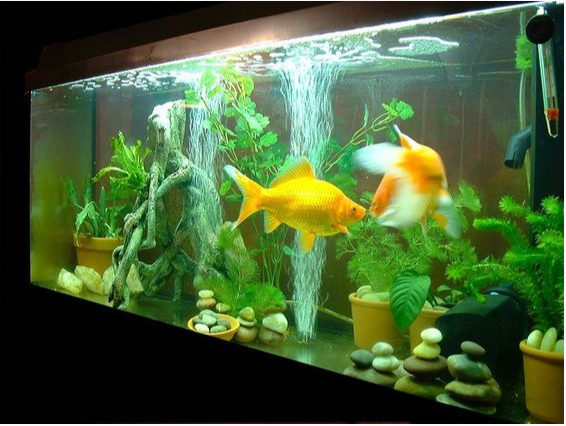If you’re passionate about creating a captivating underwater world for your fish, you’ve likely heard about the wonders of aquarium lights. These unassuming fixtures play a crucial role in not only enhancing the aesthetics of your aquatic haven but also in ensuring the well-being of your fish. In this guide, we’ll dive deep into the world of aquarium lighting, exploring how it can transform your fish tank into a mesmerizing aquatic landscape while keeping your fish happy and healthy.
Setting the Stage: Why Lighting Matters in Aquascaping
Before we delve into the technicalities of aquarium lighting, let’s understand why it’s so crucial in the world of aquascaping. Imagine walking into a dimly lit room versus a brightly lit one. The difference in ambiance is striking, and the same principle applies to your fish tank.
Lighting Enhances Visual Appeal: Properly chosen and positioned aquarium lights can make your underwater world come to life. It accentuates the vibrant colors of your fish and the lush greenery of your aquatic plants, creating a visually stunning display that’s a treat for the eyes.
Mimicking Natural Conditions: In the wild, fish and aquatic plants thrive under the influence of natural sunlight. Aquarium lights aim to replicate these conditions, providing the necessary spectrum of light for photosynthesis in plants and promoting the natural behavior of fish.
Regulating Day and Night Cycles: Just like humans, fish need a day and night cycle to thrive. Adequate lighting helps establish these cycles, allowing your fish to rest during the night and stay active during the day.
Choosing the Right Aquarium Lights
When it comes to aquarium lighting, not all lights are created equal. There’s a variety of options available, each with its unique advantages and purposes. Let’s explore the most common types:
- LED Lights: LED (Light Emitting Diode) lights are the gold standard in modern aquarium lighting. They are energy-efficient, customizable, and provide a broad spectrum of light suitable for both fish and plants. LEDs also have a long lifespan, saving you money on replacements.
- T5 Fluorescent Lights: T5 lights offer excellent brightness and color rendition, making them a popular choice for freshwater planted tanks. They come in various lengths, allowing you to choose the right size for your aquarium.
- Compact Fluorescent Lights (CFLs): CFLs are an affordable option for small aquariums or as supplemental lighting for larger setups. While not as energy-efficient as LEDs, they are readily available and can provide adequate illumination for basic setups.
- Metal Halide Lights: These high-intensity discharge lights are exceptionally bright and are often used in larger, more demanding setups, such as reef aquariums. However, they can generate heat and consume more electricity.
- Specialty Lights: Some aquarium enthusiasts use specialty lights, such as UV lights to promote the growth of beneficial bacteria, or actinic lights to enhance the colors of fluorescent fish and corals in marine tanks.
When choosing your aquarium lights, consider the specific needs of your fish and plants. Different species may require different light intensities and spectrums. Always research the lighting requirements of your aquatic inhabitants to ensure they receive the ideal conditions.
Positioning Your Aquarium Lights for Maximum Impact
Now that you’ve selected the right lights for your aquarium, it’s time to talk about placement. Proper positioning is crucial to ensure that the light reaches all corners of your tank and benefits both the aquatic life and the overall aesthetics.
- Even Distribution: Aim for uniform light distribution throughout the tank. Uneven lighting can result in shaded areas where plants struggle to grow, and fish may become stressed.
- Adjustable Height: Many aquarium lights come with adjustable brackets or hanging kits. These allow you to customize the height of the light fixture above the water’s surface. Be sure to follow the manufacturer’s recommendations for your specific light.
- Avoid Overexposure: While light is essential, too much of it can lead to algae overgrowth and stressed fish. Ensure that your lighting duration mimics a natural day-night cycle, typically around 8-10 hours of light per day.
- Monitor Light Spectrum: Some advanced LED lights allow you to adjust the light spectrum. For planted tanks, consider lights that can provide a full spectrum, including red and blue wavelengths for optimal plant growth.
- Use Timers: To maintain a consistent day-night cycle, invest in a timer for your aquarium lights. This eliminates the need for manual on/off switching and ensures your fish and plants receive consistent lighting.
Enhancing the Aquatic Experience
Beyond the technical aspects of lighting, aquarium enthusiasts often find great joy in using lights to create thematic and dramatic effects in their tanks. Here are a few creative ideas to enhance your aquatic experience:
- Moonlighting: Some aquarium lights offer moonlight settings, which emit a gentle, cool-blue glow that mimics moonlight. It’s a serene and captivating addition to your tank during nighttime hours.
- Seasonal Themes: Consider changing your lighting to match the seasons. Warmer tones in the fall and winter and cooler, brighter tones in the spring and summer can mimic the changing environment of your fish’s natural habitats.
- Floating Plants: Use floating plants like Amazon frogbit or water lettuce to create shaded areas and dappled lighting effects. This not only adds visual interest but also provides a more natural environment for your fish.
- Aquascaping Accents: Position lights strategically to highlight specific features in your aquascape, such as a beautiful

